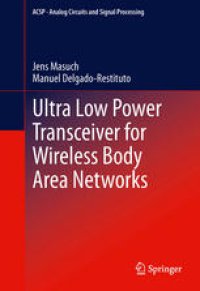
Ebook: Ultra Low Power Transceiver for Wireless Body Area Networks
- Tags: Circuits and Systems, Electronics and Microelectronics Instrumentation, Electronic Circuits and Devices
- Series: Analog Circuits and Signal Processing
- Year: 2013
- Publisher: Springer International Publishing
- Edition: 1
- Language: English
- pdf
Wireless Body Area Networks (WBANs) are expected to promote new applications for the ambulatory health monitoring of chronic patients and elderly population, aiming to improve their quality of life and independence. These networks are composed by wireless sensor nodes (WSNs) used for measuring physiological variables (e.g., glucose level in blood or body temperature) or controlling therapeutic devices (e.g., implanted insulin pumps). These nodes should exhibit a high degree of energy autonomy in order to extend their battery lifetime or even make the node supply to rely on harvesting techniques. Typically, the power budget of WSNs is dominated by the wireless link and, hence, many efforts have been directed during the last years toward the implementation of power efficient transceivers.
Because of the short range (typically no more than a few meters) and low data rate (typically in between 10 kb/s and 1 Mb/s), simple communication protocols can be employed. One of these protocols, specifically tailored for WBAN applications, is the Bluetooth low energy (BLE) standard.
This book describes the challenges and solutions for the design of ultra-low power transceivers for WBANs applications and presents the implementation details of a BLE transceiver prototype. Coverage includes not only the main concepts and architectures for achieving low power consumption, but also the details of the circuit design and its implementation in a standard CMOS technology.
This book describes the design of ultra low power transceivers for body area networks. Since these applications have very limited energy resources, typically powered only by tiny batteries or through energy harvesting techniques, this book describes an architecture for a Bluetooth low energy transceiver to overcome these limitations. Coverage includes not only the main concepts for achieving low power consumption, but also the details of the circuit design and its implementation in a standard CMOS technology.
· Guides readers through the design of ultra low power transceivers for body area networks, from architecture to circuit-level implementation;
· Describes 4 key strategies for ultra-low power transceiver design and specific, innovative techniques for circuit-level design;
· Enables readers to design transceivers for body area networks that are 27% more energy efficient than those currently available;
· Includes a review of the state-of-the-art in low-power transceivers in the GHz frequency range.
This book describes the design of ultra low power transceivers for body area networks. Since these applications have very limited energy resources, typically powered only by tiny batteries or through energy harvesting techniques, this book describes an architecture for a Bluetooth low energy transceiver to overcome these limitations. Coverage includes not only the main concepts for achieving low power consumption, but also the details of the circuit design and its implementation in a standard CMOS technology.
· Guides readers through the design of ultra low power transceivers for body area networks, from architecture to circuit-level implementation;
· Describes 4 key strategies for ultra-low power transceiver design and specific, innovative techniques for circuit-level design;
· Enables readers to design transceivers for body area networks that are 27% more energy efficient than those currently available;
· Includes a review of the state-of-the-art in low-power transceivers in the GHz frequency range.
Content:
Front Matter....Pages i-viii
Introduction....Pages 1-5
Review of the State of the Art....Pages 7-12
Low Power Strategies....Pages 13-21
Implementation of the Low Power Transceiver....Pages 23-85
Co-integration of RF Energy Harvesting....Pages 87-103
Conclusions....Pages 105-108
Back Matter....Pages 109-122
This book describes the design of ultra low power transceivers for body area networks. Since these applications have very limited energy resources, typically powered only by tiny batteries or through energy harvesting techniques, this book describes an architecture for a Bluetooth low energy transceiver to overcome these limitations. Coverage includes not only the main concepts for achieving low power consumption, but also the details of the circuit design and its implementation in a standard CMOS technology.
· Guides readers through the design of ultra low power transceivers for body area networks, from architecture to circuit-level implementation;
· Describes 4 key strategies for ultra-low power transceiver design and specific, innovative techniques for circuit-level design;
· Enables readers to design transceivers for body area networks that are 27% more energy efficient than those currently available;
· Includes a review of the state-of-the-art in low-power transceivers in the GHz frequency range.
Content:
Front Matter....Pages i-viii
Introduction....Pages 1-5
Review of the State of the Art....Pages 7-12
Low Power Strategies....Pages 13-21
Implementation of the Low Power Transceiver....Pages 23-85
Co-integration of RF Energy Harvesting....Pages 87-103
Conclusions....Pages 105-108
Back Matter....Pages 109-122
....